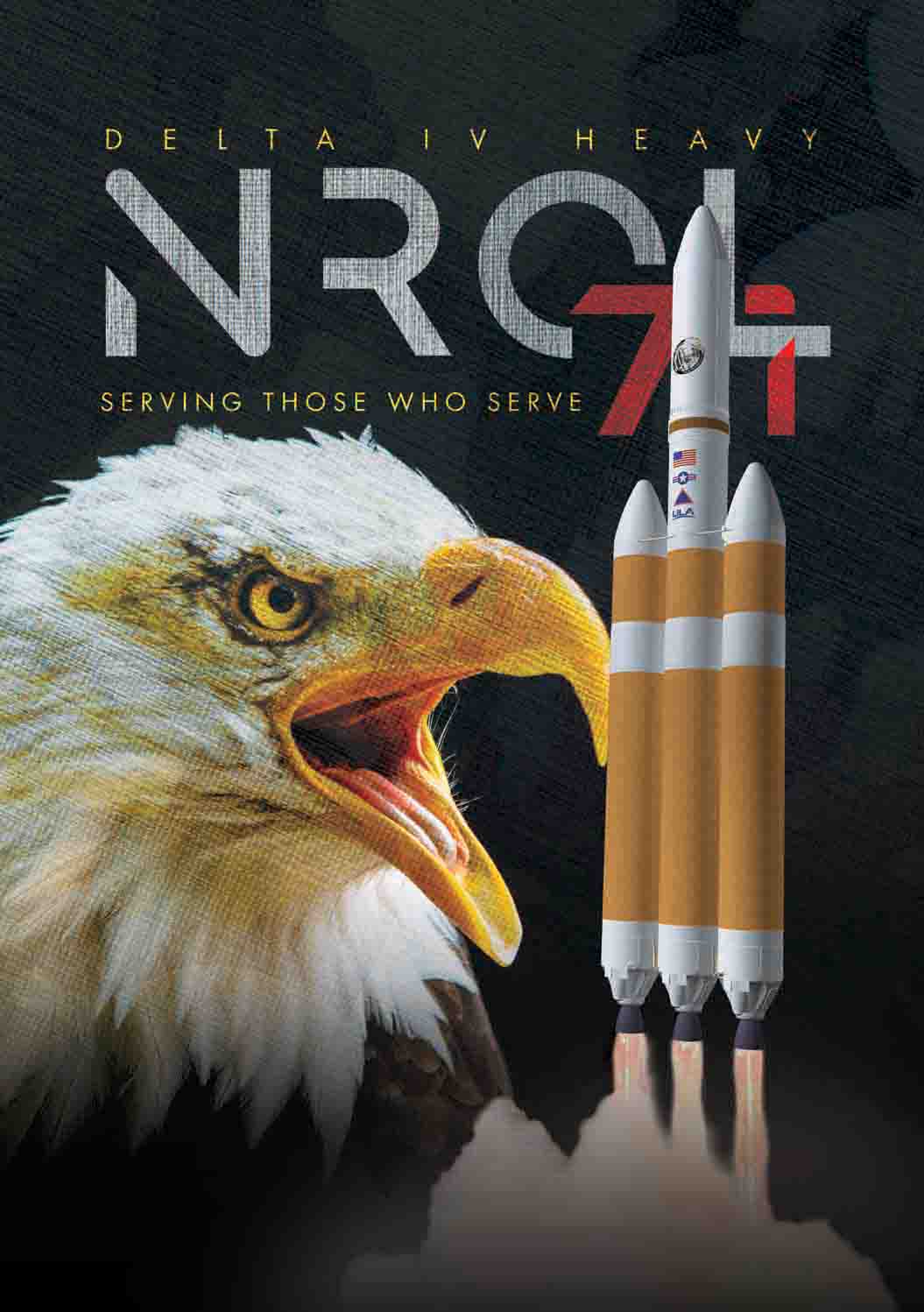Jan. 18 -- LRR completed
The Launch Readiness Review
at Vandenberg Air Force Base in California today culminated with
officials giving a unanimous “go” for liftoff of the United Launch
Alliance Delta IV Heavy rocket on the NROL-71 mission for the National
Reconnaissance Office on Saturday.
The LRR, led by Lou Mangieri, ULA’s NROL-71 launch director,
assessed all aspects of mission readiness, discussed the status of
pre-flight processing work, heard technical overviews of the countdown
and flight, and previewed the weather forecast.
At the conclusion of the meeting, senior leaders were polled and then signed the Launch Readiness Certificate.
The launch is scheduled for 11:05 a.m. PST (2:05 p.m. EST; 1905 UTC).
”We are proud to launch this critical payload in support of our
nation’s national security mission,” said Gary Wentz, ULA vice president
of Government and Commercial Programs. “As the nation’s premiere launch
provider, the teams have worked diligently to ensure continued mission
success, delivering our customer’s payloads to the precise orbits
requested.”
Weather forecasters from the Air Force’s 30th Weather Squadron
predict a 70 percent chance of favorable conditions for launch. The
outlook includes a few high-level clouds, northerly winds of 12 to 18
knots and a temperature near 60 degrees F. The only concern for a launch
weather rule violation will be winds.
United Launch Alliance will provide complete live coverage of
Saturday’s countdown in this blog starting at 2:15 a.m. PST (5:15 a.m.
EST; 1015 UTC). Our Live Launch Updates Blog brings you official and
timely information during the Delta IV Heavy rocket’s countdown with
automatically-refreshing updates.
Our live video webcast also can be viewed on this page starting from L-20 minutes at 10:45 a.m. PST (1:45 p.m. EST; 1845 UTC).
At the request of our customer, live mission coverage will
conclude after confirmation of payload fairing jettison, which is
scheduled to occur about six minutes after liftoff.
RocketStars: Lou Mangieri
Throughout our countdown today, we are highlighting key individuals who are working this Delta IV Heavy rocket launch for the National Reconnaissance Office.
Next up is Lou Mangieri, the United Launch Alliance launch director for NROL-71. He oversees the readiness of the launch vehicle to perform the mission.
“The LD is responsible to ensure the launch vehicle, spacecraft and range assets all support the T-0. He does this working with the launch conductor (launch vehicle), range coordinator (range assets) and the mission director (spacecraft),” he says.
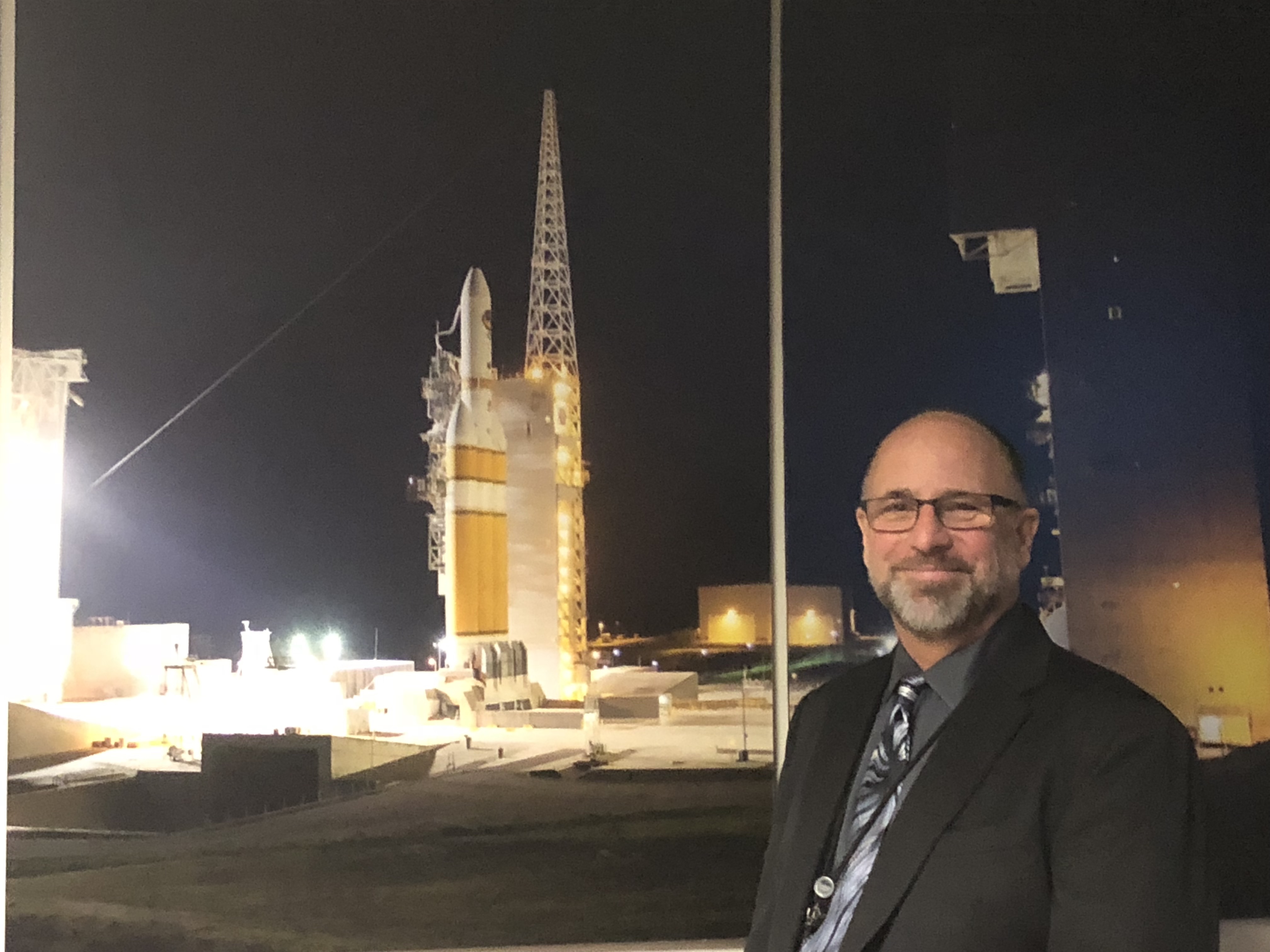
Mangieri was born in Jersey City, New Jersey and received a bachelor of science in aeronautical engineering from Embry-Riddle Aeronautical University and a master’s in space technology from Florida Institute of Technology.
“I began working for General Dynamics right out of college at Complex 36 on the Atlas program. General Dynamics brought me out for an interview during the launch of AC-56/Intelsat 501. After the launch, I told them I would accept any offer they would present. I was hooked!”
That launch in 1981 set Mangieri on a path as he rose through the ranks and obtained the role of launch director. He has served in this critical position for 44 missions.
”My first mission as LD was on Intelsat 14 on Nov. 23, 2009. It was an Atlas V 431 configuration. Since then I have sat as LD on 29 Atlas V and 15 Delta IV missions for a total of 44 missions.”
”The most rewarding aspect of being the Launch Director is knowing that I am a small part of a very dedicated and talented launch team working together to ensure we safely deliver our customer’s spacecraft on orbit.”
RocketStars: Dillon Rice
Throughout our countdown today, we are highlighting key individuals who are working this Delta IV Heavy rocket launch for the National Reconnaissance Office.
Next up is Dillon Rice, the United Launch Alliance launch conductor for NROL-71. The launch conductor orchestrates the countdown procedures from the Remote Launch Control Center, located about 11 miles from the pad.
” The launch conductor directs and manages all of the integrated countdown activities on launch day. The LC releases the final hold at T-4 minutes and has the capability to manually stop the countdown if a problem arises,” he says.
” I became a launch conductor in 2015 and worked as the assistant LC for multiple missions (approximately a dozen) before being the prime LC for a mission. L-71 is my fifth mission as a launch conductor.”
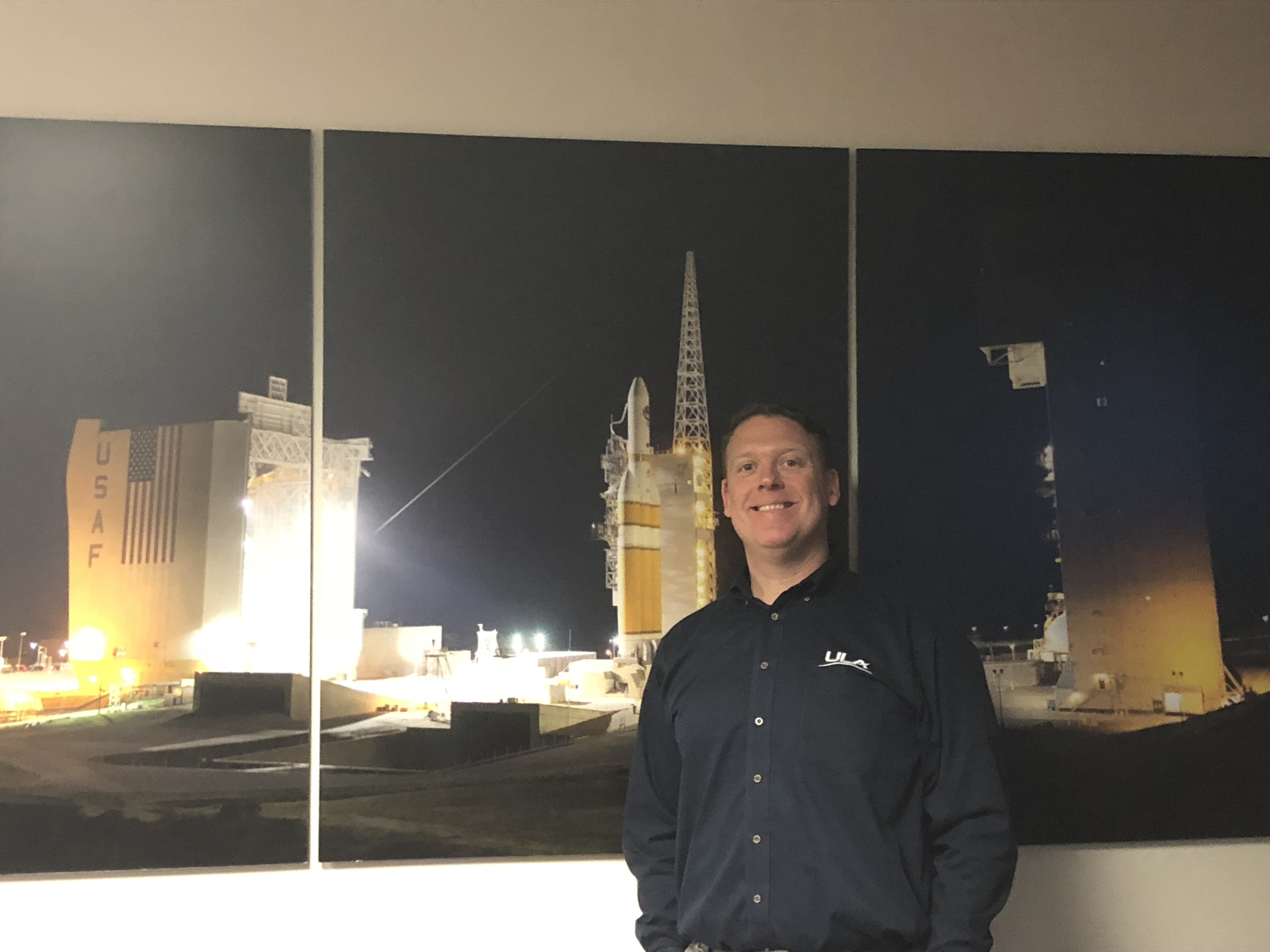
Rice was born in Jacksonville and grew up in the small town of Callahan, Florida. He has a Bachelor’s Degree in electrical engineering from the University of North Florida and a Master’s Degree in systems engineering from the University of Denver.
”I really enjoy working on cars, but Iately my techie side has me tinkering with home automation stuff.”
His aerospace career began with Boeing in 1999 as an engineer working on the construction of Cape Canaveral’s Space Launch Complex 37 for the Delta IV program.
”My first responsibilities involved the installation and checkout of the communications infrastructure. I worked as a comm engineer, a flight operations integrator and a Range coordinator prior to becoming a launch conductor.”
Coming up at L-7 minutes, you will hear Rice on the webcast perform the final pre-launch readiness poll.
”Our customer continues to entrust us with launching the nation’s most precious space-based assets and capabilities, and I remind myself of that constantly. It’s a big deal. I am honored and humbled to be given the opportunity to lead the launch team through the countdown that lofts these assets to space, and I am very proud of my small contribution to keeping our war-fighters safe and supporting the cause of peace and freedom around the world.”
RocketStars: John Myers
Throughout our countdown today, we are highlighting key individuals who are working this Delta IV Heavy rocket launch for the National Reconnaissance Office.
Next up is John Myers, the United Launch Alliance anomaly chief for NROL-71. This is position in the launch control room that directs engineering teams who resolve technical issues that arise in the countdown.
”The primary responsibility of the AC is to lead the various technical team members towards a productive solution for any technical or operational engineering issue that surfaces during the launch count. Good communication and an established process are really the keys. That said, we always hope for no issues, so the only thing I actually have to say during the count is ‘Ready’ and ‘Go,’” he said.

Myers grew up outside Chicago and attended Northwestern University to major in chemical engineering. He obtained a master’s degree in aeronautical engineering while working here at Vandenberg. His hobbies include playing tennis and racquetball, watching pro hockey, playing cards and brewing beer.
”I got my start in aerospace when I caught a lucky break in 1983, and got a job at Vandenberg to work on what was then planned to be the west coast space shuttle launch site, SLC-6. That obviously didn’t work out as planned for the space shuttle, but it worked out great for me. Starting with that first position, I have had the good fortune to help build, activate and work on multiple launch pads that have launched many different launch vehicles, ranging from Titan 34D to Delta II to Atlas V to Delta IV Heavy."
Myers become the anomaly chief for West Coast launches not long after United Launch Alliance was formed in 2006.
”As is the case for all of our console positions, I trained under more experienced mentors (also Launch Ops chief engineers) until I was ready to go solo. I have supported approximately 25 launches in this role, either as primary or backup AC.”
Asked what preparation goes into getting ready to be the anomaly chief on launch day, Myers noted that each mission and vehicle have some common characteristics, as well as some unique aspects.
”I work closely with the Launch Ops team and Denver Vehicle Systems Engineer to ensure all open technical issues encountered during mission processing are either closed or very well understood from a risk standpoint. We always try to enter the launch count with minimal risk, or have a plan to mitigate any risk that surfaces, and there is a specific process we all follow to do that. We also practice our anomaly resolution process during Wet Dress Rehearsal (WDR), Mission Dress Rehearsal (MDR) and other rehearsal exercises. Knowing that we have a well-prepared and experienced launch team makes the job that much easier on day of launch.”
Today’s launch will be Myers’ final one before retirement from ULA.
“I learned so many interesting aspects of this business, working on payloads, launch vehicles and ground systems. Getting exposure to all the engineering disciplines has really afforded me the opportunity to have a much more system-oriented view of what we do, so I have definitely enjoyed that.
”Some of my favorite memories include the recently retired Delta II, particularly when we launched one mission every month for a year at SLC-2 during the Iridium campaign in the late 90’s. Having the opportunity to help build and activate SLC-6 (twice), and then launch the first West Coast Delta IV Medium, and then to be able to do it again for the first West Coast Delta IV Heavy – that will always be something special to me. I’m really pleased that my last launch here will be supporting one of our most important customers with this great launch vehicle, and with the great launch team we have at ULA. I will always remember it.
”Finally, in looking back at my 35 years at Vandenberg, I can say it’s been an a real honor to work with so many dedicated professionals that come to work each day for much more than a paycheck. That is not always so easy to find in such a difficult and unforgiving business, one that requires so much dedication and so little room for error.”
RocketStars: Shannon Curtis
Throughout our countdown today, we will be highlighting key individuals who are working this Delta IV Heavy rocket launch for the National Reconnaissance Office.
First up is Shannon Curtis, the United Launch Alliance stand engineer at Space Launch Complex 6 for NROL-71. The stand engineer is the launch control room’s main point person at the launch pad to direct the execution of steps and procedures during the early hours of the countdown.
"The stand engineer’s primary responsibilities include securing the pad before launch," she said. "They also act as the communication link between the launch conductor and what is happening on the pad. This means providing updates from the start of MST roll all the way to final pad clear."
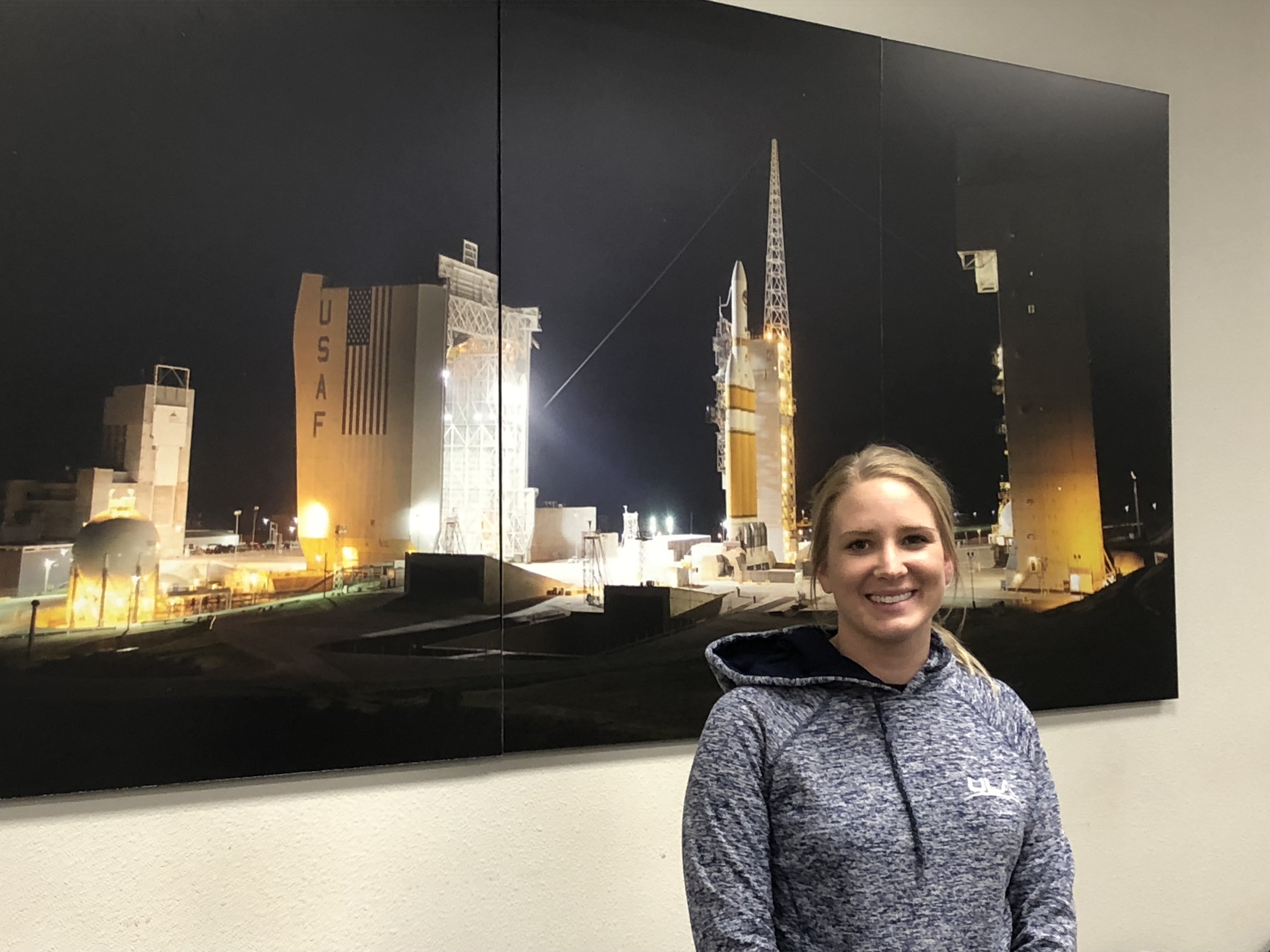
Curtis was born and raised in Littleton, Colorado and went to college at the Milwaukee School of Engineering where she pursued a degree in industrial engineering and pitched for the school’s softball team. Outside of work, she enjoys traveling, hiking, kayaking and golf.
"I started at ULA as an intern in the Delta IV mechanical engineering group. After graduating from college in May 2017, I hired on as a systems test engineer in the same group I interned in. I have had the opportunity over the past year and a half to work on all five ULA launch pads, doing a variety of work on Delta and Atlas vehicles."
Besides working countdowns, Curtis is involved in critical operations to prepare the rockets for flight.
"I take part in different lift and mate operations for the Delta IV vehicles. I lead technicians in installing flight hardware on all parts of the rocket," she said.
Later today, she will verify the completion of hands-on work at the launch pad and receive the instruction from the launch conductor for all personnel to clear the complex.
"When you're the stand engineer, you, safety and security are the last people to leave. We complete a final count to ensure everyone has left and then we flip the lights to flashing red. I head for the fall back area and watch the launch from SLC-3 at Vandenberg. I am about as close to the launch as it is safe to be," she said.
"Launch day is always the most exciting day. We spend months processing the vehicle and it’s all gone in a couple minutes. It's rewarding being one of the last people to see it in person and up close. I like knowing that I took part in readying the vehicle for its departure."
2:15 a.m. PST (5:15 a.m. EST; 1015 UTC)
From Vandenberg Air Force Base in California, this is Delta Launch Control at T-minus 8 hours and holding.
The countdown activities are about to begin for today’s liftoff
of the United Launch Alliance Delta IV Heavy rocket on the NROL-71
mission for the National Reconnaissance Office.
Launch is scheduled for 11:05 a.m. PST (2:05 p.m. EST; 1905 UTC) from Space Launch Complex 6 on the southern end of Vandenberg.
The countdown will start at 2:35 a.m. PST from the T-minus 8 hour
mark. Two pre-planned, 15-minute built-in holds scheduled in the count.
One pause is reserved prior to fueling at T-minus 4 hours, 15 minutes,
the other occurs prior to the terminal count at T-minus 4 minutes.
But the first order of business this morning is retracting the
Mobile Service Tower away from the rocket and into its launch position. A
weather briefing for tower roll was just completed, and conditions are
verified acceptable for the move as well as the rest of the day while
the vehicle stands exposed on the pad. ULA Launch
Director Lou Mangieri then gave the official “go” to the launch team for
rollback of the gantry.
2:35 a.m. PST (5:35 a.m. EST; 1035 UTC) -- Countdown begins
Countdown
clocks have been initiated at Vandenberg for today’s Delta IV Heavy
launch. We are just eight-and-a-half hours away from liftoff of the
triple-core rocket on a vital mission for U.S. national security.
The application of power to the avionics aboard the Delta IV
Heavy rocket is beginning at the start of the countdown. The equipment
will be powered up for launch day testing and final preparations for
fueling operations.
For launch today at 11:05 a.m. PST, Air Force meteorologists are
predicting a few high clouds, good visibility, northerly winds of 12-18
knots and a temperature near 60 degrees F.
Overall, there is a 70 percent chance of favorable launch weather, with winds the only concern.
3:18 a.m. EST (6:18 a.m. EST; 1118 UTC)
The Delta IV Heavy rocket has been powered up for its launch on NROL-71.
3:36 a.m. EST (6:36 a.m. EST; 1136 UTC)
Guidance
system testing is getting started at this point in the countdown as we
continue to press ahead toward a liftoff at 11:05 a.m. PST (2:05 p.m.
EST; 1905 UTC).
3:55 a.m. PST (6:55 a.m. EST; 1155 UTC)
Retraction
of the Mobile Service Tower has begun at Space Launch Complex 6. First
motion occurred at 3:54 a.m. PST (6:54 a.m. EST; 1154 UTC).
The tower was raised several inches to allow an undercarriage
transport system to move the gantry to its launch position east of the
rocket.
4:06 a.m. PST (7:06 a.m. EST; 1206 UTC)
The MST has
moved 25 feet clear of the launch vehicle as the roll continues. The
first part of retraction moves at a snail’s pace to ensure proper
clearance of gantry structures with the vehicle. Once clear, the speed
will increase.
4:10 a.m. PST (7:10 a.m. EST; 1210 UTC)
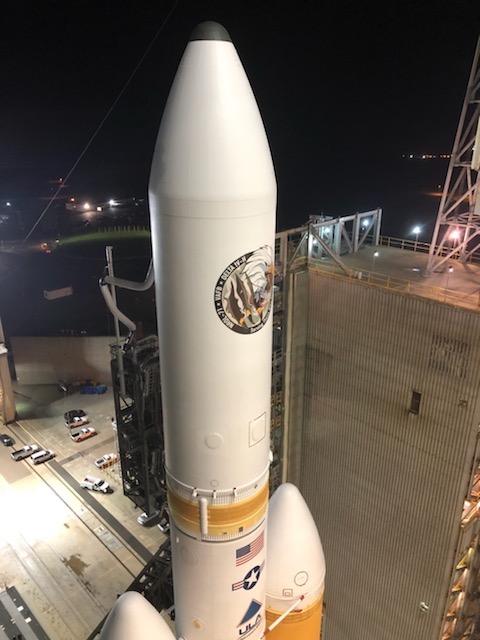
Photo by United Launch Alliance
4:15 a.m. PST (7:15 a.m. EST; 1215 UTC)
Space Launch
Complex 6 is the West Coast home of the Delta IV rocket at Vandenberg
Air Force Base in California. “Slick Six” was constructed by the Air
Force in the 1960s for the Manned Orbiting Laboratory program and
modified in the 1980s to be a polar launch site for the space shuttle.
Both projects were cancelled before the site hosted a launch of either
project. It was briefly used in the 1990s for Lockheed Martin’s small
Athena rocket.
The pad was rejuvenated in an extensive overhaul to support the
Delta IV starting in 2000. The launch table was constructed, a hydraulic
erector system installed, the Fixed Umbilical Tower modified and swing
arms added, the Mobile Service Tower was retrofitted and a nearby
horizontal processing hangar built.
NROL-71 will be the 12th launch from this complex and the 8th by a Delta IV.
4:30 a.m. PST (7:30 a.m. EST; 1230 UTC)
The flight
control operational test has been conducted on the Delta IV Heavy
rocket. This test is known as flight slews, which will perform gimbal
checks of the rocket engine nozzles on the vehicle, in a state prior to
cryogenic fueling.
4:40 a.m. PST (7:40 a.m. EST; 1240 UTC)
This is
Delta Launch Control at T-minus 5 hours, 55 minutes (L-6 hours 25
minutes) and counting. The mobile gantry at Space Launch Complex 6 has
reached its park position, revealing the United Launch Alliance Delta IV
Heavy rocket for the NROL-71 mission for the National Reconnaissance
Office today.
The MST is a 32-story structure that weighs 13 million pounds. It
is a critical part of the launch complex, proving the primary access
and weather protection to the rocket during its stay on the launch pad,
and its overhead crane system serves a vital role in vertical
integration of payloads onto Delta IV rockets.
Rollback of the MST signals a major milestone early in launch day
operations. Configuring launch pad systems and securing equipment will
be completed over the next couple of hours before all personnel clear
the site for fueling.
Activities remain on schedule for a liftoff at 11:05 a.m. PST (2:05 p.m. EST; 1905 UTC).
5:00 a.m. PST (8:00 p.m. EST; 1300 UTC)
Throughout our countdown today, we will be highlighting key individuals who are working this Delta IV Heavy rocket launch for the National Reconnaissance Office.
First up is Dillon Beaver, the United Launch Alliance pad safety engineer at Space Launch Complex 6 for NROL-71. This job ensures the overall safety of personnel at the pad during pre-flight activities.
”The primary responsibilities of the pad safety engineer during launch day is to oversee the safety of everyone on the pad, cordon off hazardous operational areas as they commence throughout the countdown, and coordinate with range safety and security to verify all areas within the explosive clear zone have been evacuated prior to launch,” he says.
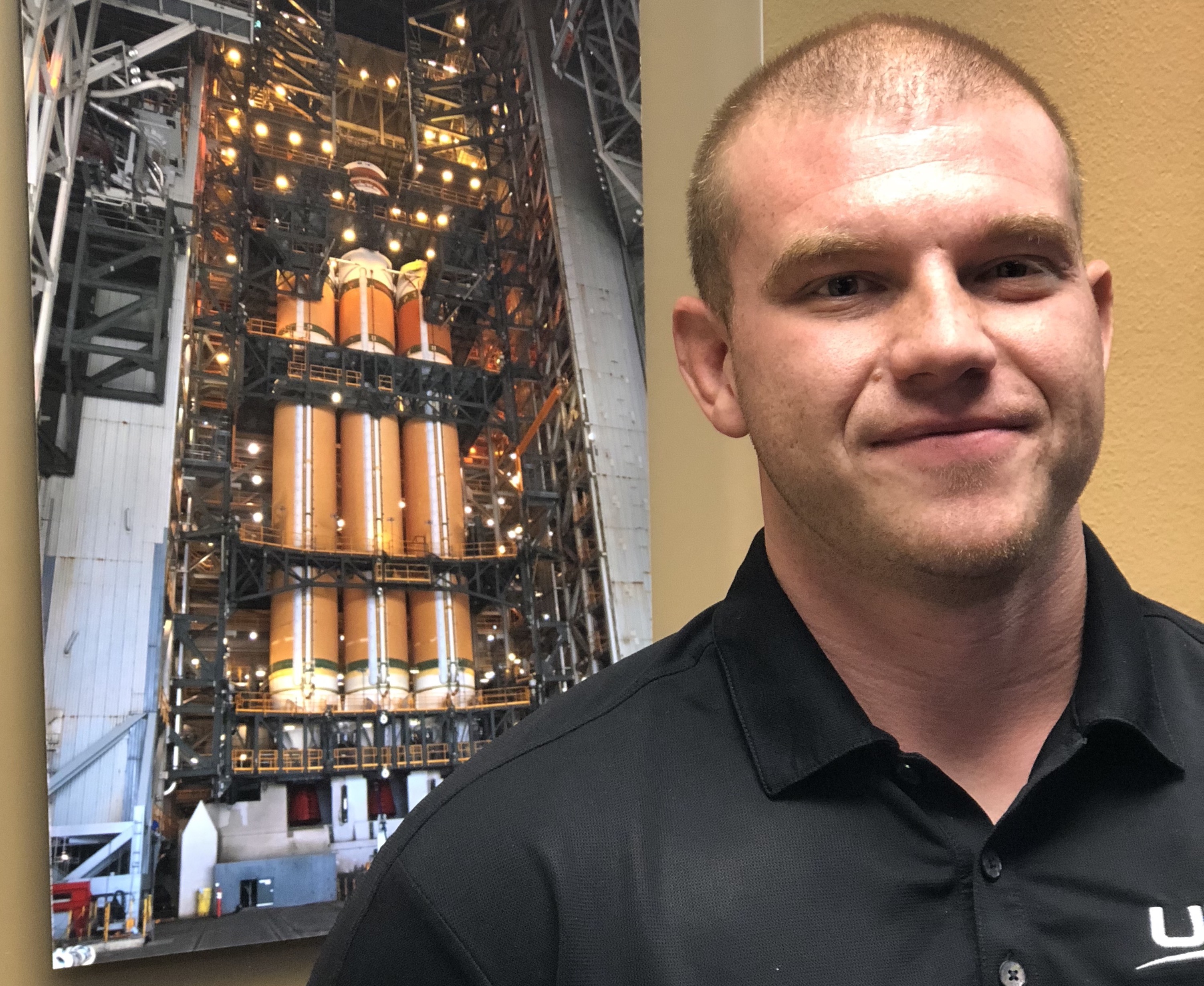
Beaver was born in Joplin, Missouri and received a degree in environmental health and safety management from Northeastern State University in Tahlequah Oklahoma. He began his career aerospace as a pad safety engineer working on a Delta IV Heavy launch from Cape Canaveral in 2016.
When not working, Beaver enjoys hunting, fishing, hanging out with friends and riding his Harley.
”The most rewarding aspect of being a Pad Safety Engineer is knowing that everyone goes home safely to their families following a successful launch.”
5:14 a.m. PST (8:14 a.m. EST; 1314 UTC)
This is Delta Launch Control at T-minus 5 hours, 21 minutes (L-5 hours, 51 minutes) and counting.
The initiation of gaseous nitrogen flow to the launch vehicle has
started. This changes the environmental control systems to supply
conditioned nitrogen gas rather than air to the internal compartments of
the Delta IV Heavy rocket and the payload fairing in preparation for
the transfer of cryogenic propellants and in-flight environments.
We are tracking no issues this evening. An update from the Air Force launch weather officer is coming up in about an hour.
5:35 a.m. PST (8:35 a.m. EST; 1335 UTC)
The
countdown is being orchestrated from the Remote Launch Control Center,
located about 11 miles from the pad, where ULA Launch Conductor Dillon
Rice and his team execute the countdown sequence for the Delta IV Heavy
rocket.
Down the hall in the Mission Director’s Center, senior managers,
including ULA Launch Director Lou Mangieri and NRO Mission Director Col.
Matthew Skeen, provide guidance to the team throughout today’s
operation.
5:46 a.m. PST (8:46 a.m. EST; 1346 UTC)
The launch
pad crew is finishing up its hands-on work to ready Space Launch Complex
6 for today’s mission, and the launch conductor has given the
instruction for personnel to begin clearing the site in advance of
fueling operations. Liftoff remains scheduled for just over five hours
from now.
6:00 a.m. PST (9:00 a.m. EST; 1400 UTC)
Pre-fueling
tests are underway to verify the proper functions of liquid oxygen and
liquid hydrogen valves on all stages of the launch vehicle.
6:10 a.m. PST (9:10 a.m. EST; 1410 UTC) – Weather 70% GO
This
is Delta Launch Control at T-minus 4 hours, 25 minutes (L-4 hours, 55
minutes) and counting. In the pre-fueling weather briefing, conditions
at Vandenberg are acceptable for proceeding into cryogenic tanking
operations at Space Launch Complex 6.
Lt. Daniel Smith, the launch weather office from the Air Force's
30th Weather Squadron, also reports that the weather outlook remains
favorable for the flight of Delta IV Heavy and NROL-71 this morning. The
forecast calls for a 70 percent chance of allowable liftoff conditions,
with just high cirrus clouds, good visibility, northerly winds of 12 to
18 knots and a temperature near 60 degrees F.
The only concern will be wind gusts.
6:20 a.m. PST (9:20 a.m. EST; 1420 UTC) -- Countdown holding
This
is Delta Launch Control at T-minus 4 hours, 15 minutes and holding. The
countdown has entered the first of two planned, built-in holds that are
scheduled in today’s timeline. Each is 15-minute blocks of time that
gives the countdown some margin to resolve issues or catch up on work
could be running behind.
This particular hold serves as a margin before fueling operations
begin. At the present time, however, all activities are on schedule and
no significant problems are being addressed by the launch team.
The final hold occurs at T-minus 4 minutes.
6:25 a.m. PST (9:25 a.m. EST; 1425 UTC)
The call to stations for cryogenic tanking has been announced. A readiness poll will be conducted in five minutes.
6:33 a.m. PST (9:33 a.m. EST; 1433 UTC) – GO for fueling
A
readiness poll of the launch team by Launch Conductor Dillon Rice, with
concurrence of ULA Launch Director Lou Mangieri has authorized
cryogenic tanking operations to begin as the countdown continues this
morning. The Delta IV Heavy rocket will be loaded with approximately
470,000 gallons of liquid oxygen and liquid hydrogen over the next
couple of hours.
6:35 a.m. PST (9:35 a.m. EST; 1435 UTC) -- Countdown resumes
This
is Delta Launch Control at T-minus 4 hours, 15 minutes and counting.
The next phase of today’s launch countdown has been initiated on
schedule as we continue to target 11:05 a.m. PST (2:05 p.m. EST; 1905
UTC) for liftoff of the United Launch Alliance Delta IV Heavy rocket on
NROL-71.
Preparatory steps for fueling are being kicked off, including
liquid hydrogen storage tank pressurization and charging the helium
bottles on the three common booster cores and second stage.
6:50 a.m. PST (9:50 a.m. EST; 1450 UTC)
Watch a preview video of what to expect during liftoff of the Delta IV Heavy rocket on NROL-71 tonight.
6:56 a.m. PST (9:56 a.m. EST; 1456 UTC) – Chilldown begins
A
"go" has been given to start the cold gas chilldown conditioning of the
liquid hydrogen systems on the three common booster cores. This is the
precursor step before filling the stages with propellant.
The three common booster cores will be loaded with 330,000
gallons of super-cold liquid hydrogen that is chilled to minus-423
degrees Fahrenheit. The liquid hydrogen, along with the liquid oxygen to
be loaded shortly as well, will be consumed by the three RS-68A main
engines during the first minutes of the launch to exit Earth’s
atmosphere.
The port and starboard boosters will fire at full throttle for
nearly four minutes and then separate. The center booster burns at
partial thrust for most of that time in a fuel-conservation mode until
the outer cores jettison, then its RS-68A engine revs up to full
throttle for another minute-and-a-half of propulsion before staging.
7:15 a.m. PST (10:15 a.m. EST; 1515 UTC) – CBC LH2 loading begins
This
is Delta Launch Control at T-minus 3 hours, 35 minutes and counting.
The cold gas chilldown conditioning of the common booster cores’ liquid
hydrogen system has been accomplished, clearing the way to begin
propellant loading in "slow-fill" mode. That will transition to
"fast-fill" after a small portion of the tanks are loaded.
7:16 a.m. PST (10:16 a.m. EST; 1516 UTC)
The fueling
specialist in the launch control room confirms that liquid hydrogen is
flowing into the Delta IV Heavy rocket at the Space Launch Complex 6
pad.
7:20 a.m. PST (10:20 a.m. EST; 1520 UTC)
See our Flickr page for a collection of beautiful photos of the Delta IV Heavy rocket taken by United Launch Alliance during rollback of the Mobile Service Tower earlier today.
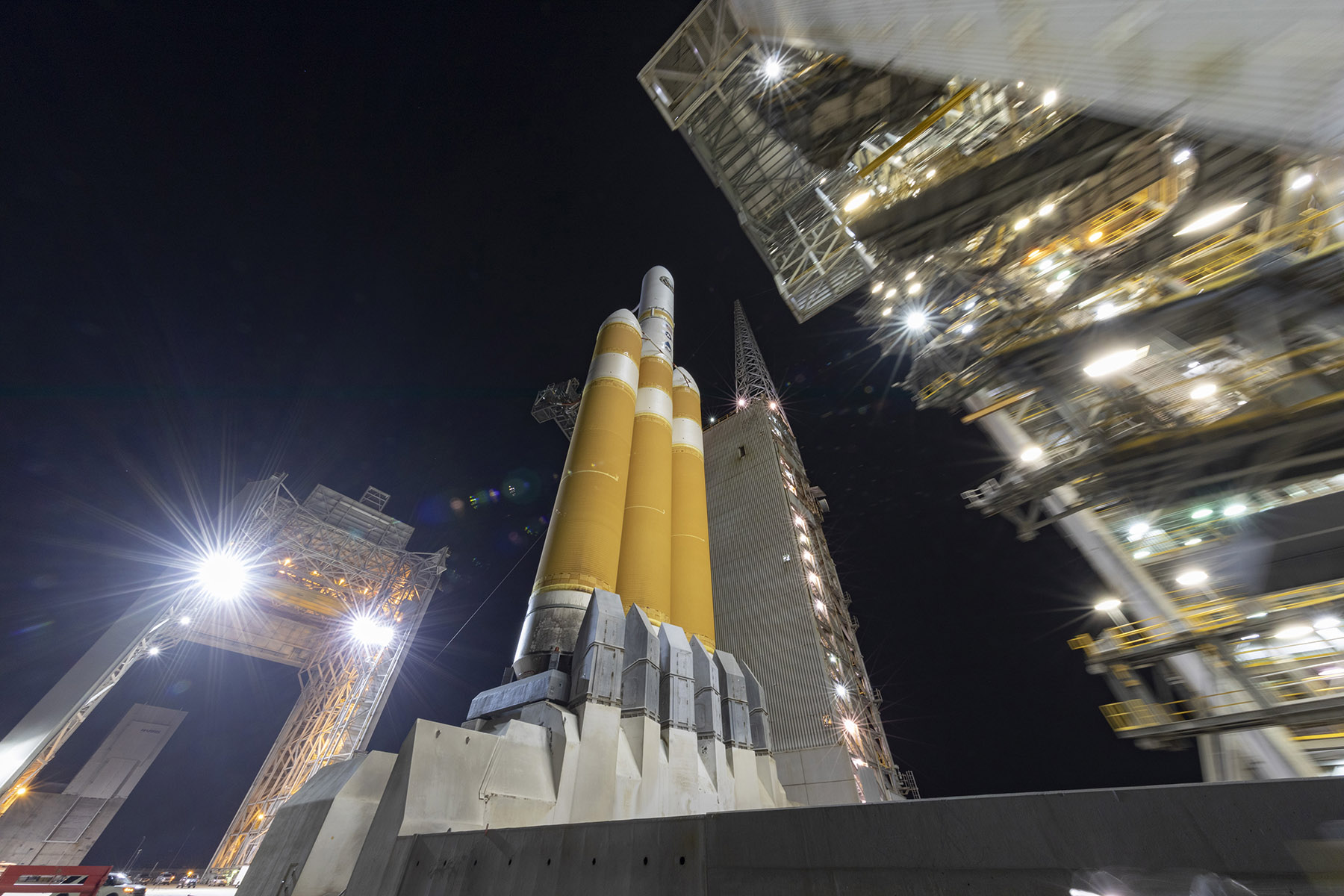
7:26 a.m. PST (10:26 a.m. EST; 1526 UTC) – CBC LOX chilldown
This
is Delta Launch Control at T-minus 3 hours, 24 minutes (L-3 hours, 39
minutes) and counting. The thermal condition process, known as
chilldown, has started for the liquid oxygen systems on Delta IV Heavy
rocket's three common booster cores. This preps the tanks and plumbing
to guard against shock when the super-cold oxidizer begins flowing into
the rocket stages.
7:28 a.m. PST (10:28 a.m. EST; 1528 UTC)
The common booster cores liquid hydrogen loading operation is switching from "slow-fill" to "fast-fill" mode as planned.
The cryogenics are fed to the three CBCs via umbilicals from the tail service masts on the launch table.
7:31 a.m. PST (10:31 a.m. EST; 1531 UTC)
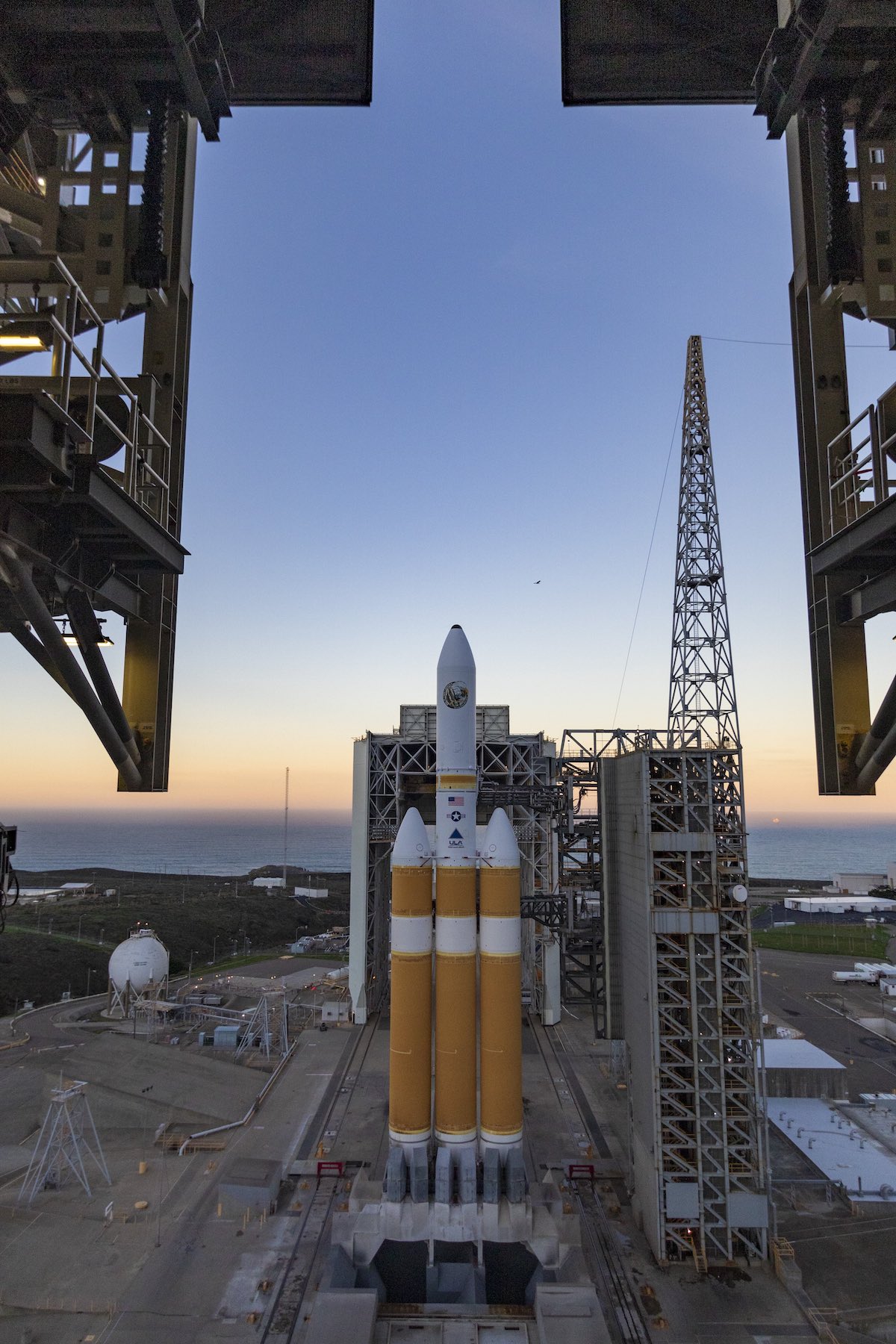
Photo by United Launch Alliance
7:38 a.m. PST (10:38 a.m. EST; 1538 UTC) – CBC LOX loading begins
This
is Delta Launch Control at T-minus 3 hours, 12 minutes and counting.
The liquid oxygen chilldown is complete for the three booster cores,
allowing 120,000 gallons of super-cold LOX to begin transferring into
the rocket for today’s launch.
7:47 a.m. PST (10:47 a.m. EST; 1547 UTC) – DCSS LH2 chilldown
The
“go” has been given to start the chilldown conditioning of the Delta
Cryogenic Second Stage liquid hydrogen system in preparation for filling
that tank.
7:55 a.m. PST (10:55 a.m. EST; 1555 UTC)
The common
booster core liquid oxygen tanking operation is switching from
"slow-fill" to "fast-fill" mode. The LOX is chilled to minus-298 degrees
F.
8:01 a.m. PST (11:01 a.m. EST; 1601 UTC) – DCSS LOX chilldown
This
is Delta Launch Control at T-minus 2 hours, 49 minutes and counting.
Approval has been given to the operators at the fueling console here in
the Remote Launch Control Center to begin the second stage liquid oxygen
chilldown procedures.
8:05 a.m. PST (11:05 a.m. EST; 1605 UTC) – DCSS LH2 loading begins
The
next step in fuel operations is getting underway by loading 14,000
gallons of liquid hydrogen into the Delta Cryogenic Second Stage
following completion of that system’s chilldown.
The stage receives its fuel from the launch pad’s upper swing arm
that extends from the Fixed Umbilical Tower to the Delta IV Heavy
rocket.
8:12 a.m. PST (11:12 a.m. EST; 1612 UTC) – DCSS LOX loading begins
Chilldown
of the second stage liquid oxygen system is complete, and the vehicle
is ready to begin receiving 6,000 gallons of LOX for launch. This is the
last of the rocket's cryogenic tanks to be filled in today's countdown.
8:17 a.m. PST (11:17 a.m. EST; 1617 UTC)
This is
Delta Launch Control. We have finished the “fast-fill” loading mode for
the three common booster core liquid hydrogen tanks, and the
post-fueling checks and valve tests are underway before topping
commences.
8:20 a.m. PST (11:20 a.m. EST; 1620 UTC)
Throughout our countdown today, we are highlighting key individuals who are working this Delta IV Heavy rocket launch for the National Reconnaissance Office.
Next up is Kara Parks, the United Launch Alliance LOX2 console operator in the launch control center for NROL-71. This is position that oversees the Delta Cryogenic Second Stage liquid oxygen tank.
”LOX2 is responsible for filling the liquid oxygen tank on the second stage and addressing any associated anomalies with the second stage liquid oxygen system. As a ULA console operator, I have to be disciplined, competent, confident, tough, and vigilant. I am responsible for the success of my system and as a team we are responsible for the success of the rocket. Our teamwork is the greatest strength of the NROL-71 launch team As LOX2, I work with nearly every other propulsion position and require flawless work from the electrical and software teams to achieve successful second stage fill,” Parks said.
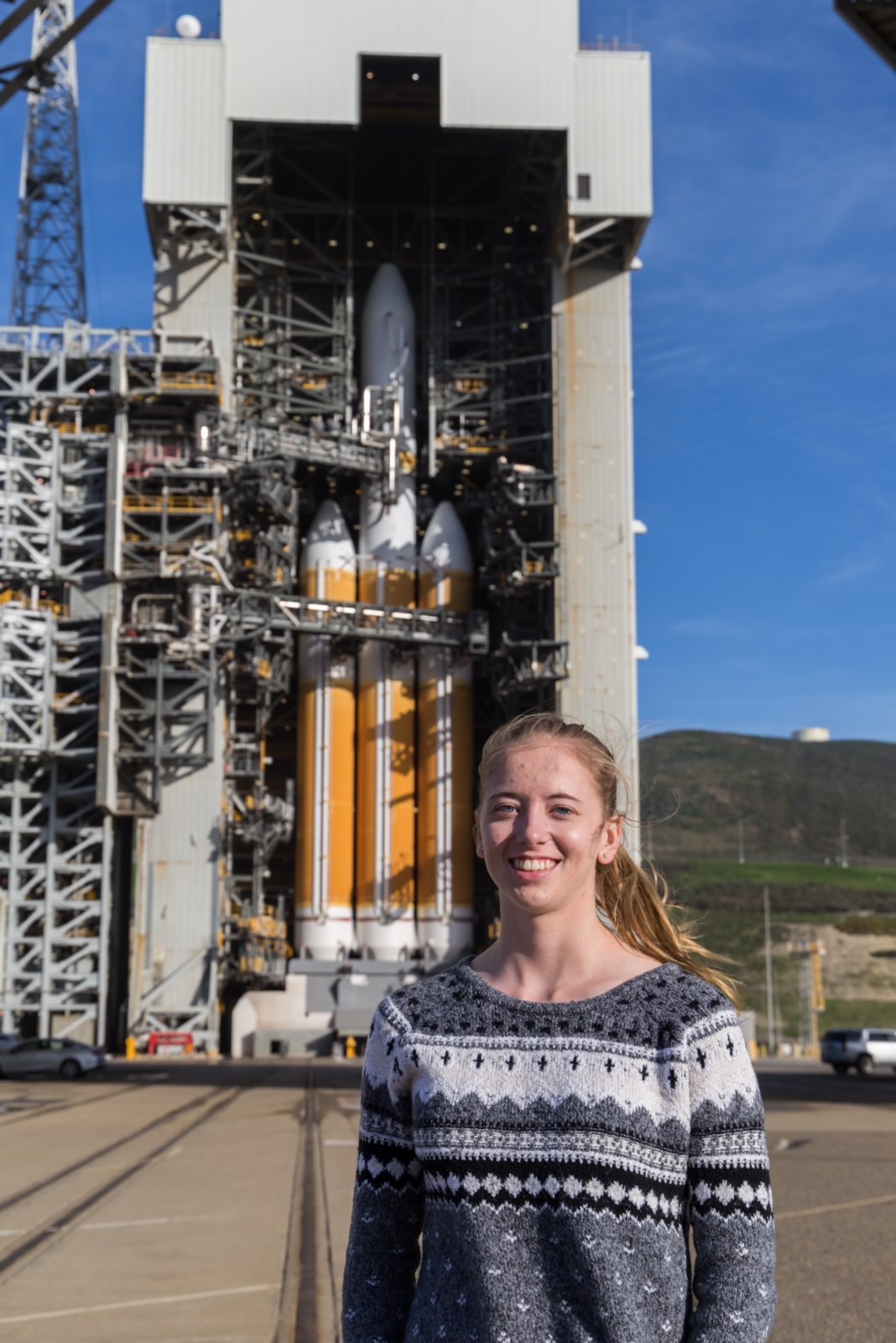
Parks was born in Jarrettsville, Maryland and earned a degree in mechanical engineering from the University of Alabama in 2017. She is currently working on a master’s in space systems engineering at Johns Hopkins University.
She began her career in aerospace at ULA as an intern in 2016, has worked on six missions and became LOX2 on the Parker Solar Probe launch last summer on the most recent Delta IV Heavy.
“I am blessed to have been an operator during the launch of such an historical and meaningful mission,” she said.
”I enjoy running, longboarding, hiking, flag football, surfing, field hockey and beach volleyball. I’m an avid griller, and love hosting parties at my home. I am skilled at making stained glass art and like to build glass projects in my garage. I love technology, so you can also find me experimenting with building video games and messing with virtual and augmented reality,” she said.
8:31 a.m. PST (11:31 a.m. EST; 1631 UTC)
Liquid oxygen loading to the three common booster cores to 96 percent has finished. Topping will be completed shortly.
9:05 a.m. PST (12:05 p.m. EST; 1705 UTC)
The NROL-71 patch is emblazoned on the Delta IV Heavy rocket’s payload fairing. Here’s the story behind the art:
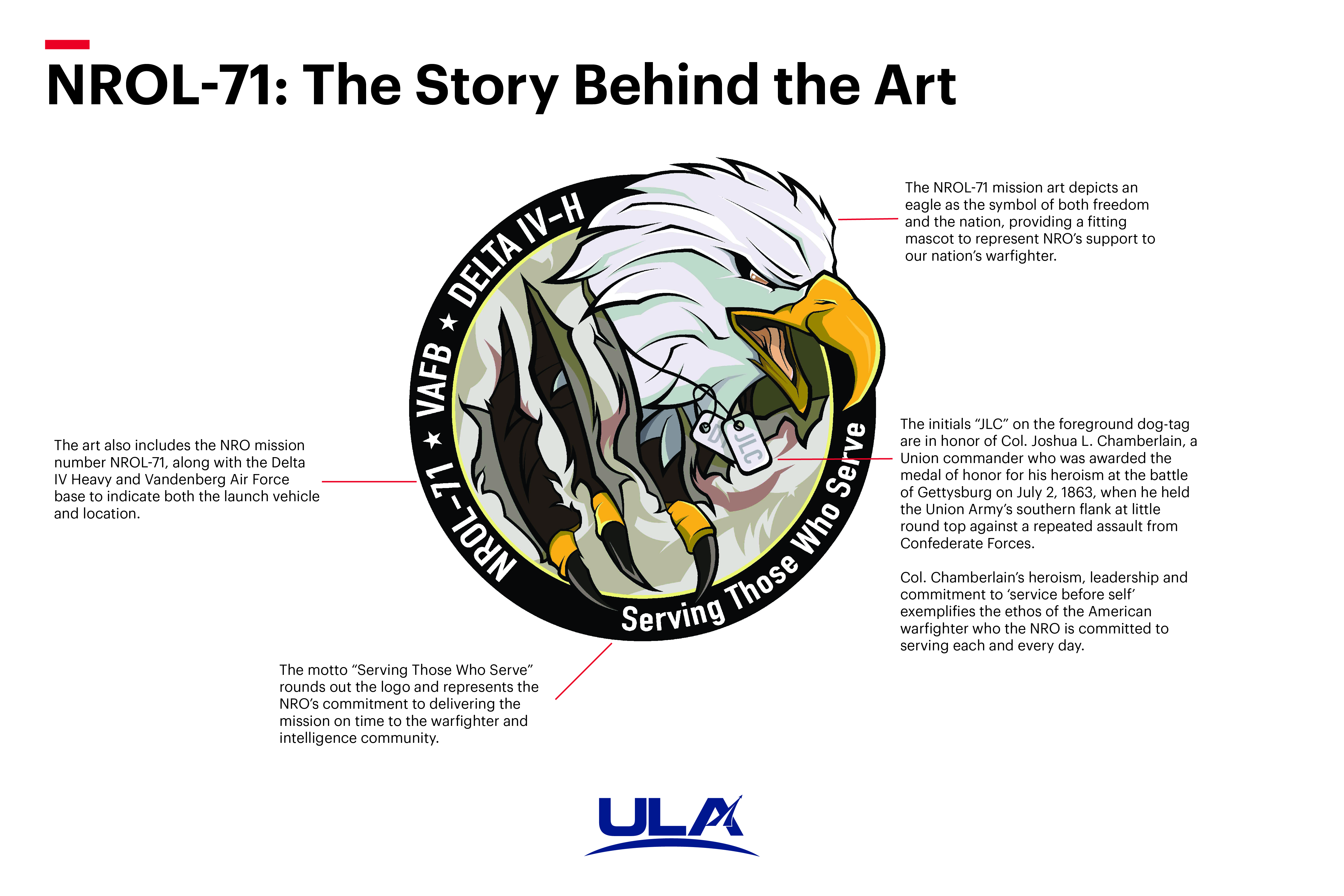
9:05 a.m. PST (12:05 p.m. EST; 1705 UTC)
The NROL-71 patch is emblazoned on the Delta IV Heavy rocket’s payload fairing. Here’s the story behind the art:
9:14 a.m. PST (12:14 p.m. EST; 1714 UTC)
The Delta
Cryogenic Second Stage has been loaded with its liquid hydrogen fuel
supply. The propellant, along with liquid oxygen that continues to be
filled, will be consumed by the stage’s RL10B-2 engine.
9:20 a.m. PST (12:20 p.m. EST; 1720 UTC
United Launch Alliance is using its Delta IV Heavy rocket to launch the NROL-71 mission for the National Reconnaissance Office. The NRO is a U.S. government agency responsible for developing, acquiring, launching, and operating America’s intelligence satellites.
The National Reconnaissance Office's systems are critical to national security, U.S. policy makers, and warfighters. These systems provide the foundation for global situational awareness, and address the nation's toughest intelligence challenges. Frequently, NRO systems are the only collectors able to access critical areas of interest, and data from overhead sensors provides unique information and perspectives not available from other sources.
The NRO's key customers and mission partners include: policy makers, the Armed Services, the Intelligence Community, Departments of State, Justice and Treasury, and civil agencies. All of them depend on the unique capabilities NRO systems provide:
- Monitoring the proliferation of weapons of mass destruction
- Tracking international terrorists, drug traffickers, and criminal organizations
- Developing highly accurate military targeting data and bomb damage assessments
- Supporting international peacekeeping and humanitarian relief operations
- Assessing the impact of natural disasters, such as earthquakes, tsunamis, floods, and fires.
Together with other Defense Department satellites, the NRO systems play a crucial role in providing global communications, precision navigation, early warning of missile launches and potential military aggression, signals intelligence, and near real-time imagery to U.S. forces to support the war on terrorism and other continuing operations.
NRO satellites also support civil customers in response to disaster relief and environmental research. Scientists created a global environment database using NRO imagery to help predict climate change, assess crop production, map habitats of endangered species, track oil spills, and study wetlands. NRO data also forms the basis for products that help depict and assess the devastation in areas affected by natural disasters.
The NRO's innovation also inspired technology in everyday life with contributions to medical imaging, global communications, high-definition television, cellular phones, the global positioning system (GPS), and much more.
With its vigilance from above, the NRO gives America's policymakers, intelligence analysts, warfighters and homeland security specialists the critical information they need to keep America safe, secure, and free.
9:26 a.m. PST (12:26 p.m. EST; 1726 UTC)
Loading of
the upper stage liquid oxygen tank was just reported complete, giving
us a 1.6-million-pound Delta IV Heavy rocket that is fueled for launch
at 11:05 a.m. PST (2:05 p.m. EST; 1905 UTC) today. At T-minus 1 hour, 24
minutes and counting, this is Delta Launch Control.
9:30 a.m. PST (12:30 p.m. EST; 1730 UTC)
The standard post-fueling inspections of the rocket’s outer thermal insulation is underway using launch pad cameras.
9:50 a.m. PST (12:50 p.m. EST; 1750 UTC)
This is
Delta Launch Control at T-minus 60 minutes and counting. We will be
taking the countdown clock to T-minus 4 minutes before holding there for
a pre-planned, 15-minute built-in hold. That is when the status polls
by management will be performed to verify all is in readiness for
liftoff.
9:51 a.m. PST (12:51 p.m. EST; 1751 UTC)
Jim Zimmerle, ULA chief engineer, explains the previous launch postponements for this Delta IV Heavy mission. Watch the video.
9:55 a.m. PST (12:55 p.m. EST; 1755 UTC)
The launch
team is proceeding with flight slews, the next major milestone in the
countdown. This is the steering test patterns run on the Delta IV Heavy
rocket nozzles to ensure proper gimbaling during the ascent.
10:00 a.m. PST (1:00 p.m. EST; 1800 UTC)
Throughout our countdown today, we are highlighting key individuals who are working this Delta IV Heavy rocket launch for the National Reconnaissance Office.
Next up is Jason Sullivan, the United Launch Alliance flight control console operator in the launch control room for NROL-71. This is position interfaces directly with the rocket and its flight computer throughout the countdown.
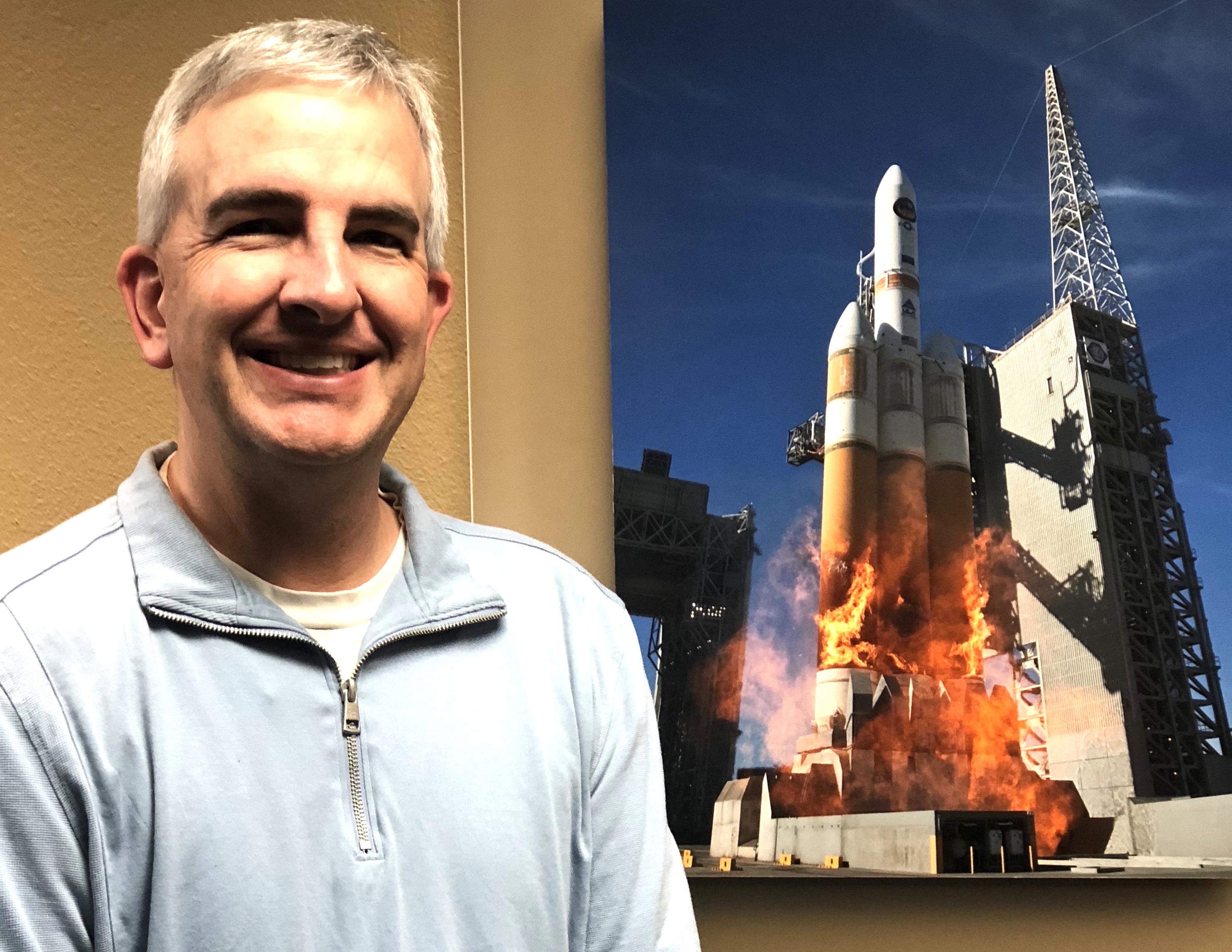
”Flight control is a pretty busy position during a countdown. The first task is applying power to the vehicle, which kicks off at T-minus 8 hours and takes about 45 minutes. Following that, we start our avionics testing, which basically entails exercising every switch that we can on the vehicle, as well as performing some redundancy testing and testing discrete interfaces to the ground via the umbilicals. After the guidance computer (INCA) has been allowed to warm up, we start guidance testing, which takes approximately two-and-a-half hours. After getting the guidance tests started, we perform slewing of both the first and second stage engines. All of this testing completes just prior to the start of the T- minus 4:15 hold,” he said.
”Coming out of the hold, we perform the ECU BIT test, which cycles the hydraulically actuated engine valves on the first stage prior to the start of cryo loading. We then have a relatively quiet few hours until about an hour before T-0, when we perform additional slewing of the engines after cryos have been loaded. We also load the ADDJUST parameter set into INCA, which allows INCA to adjust the vehicle’s trajectory based upon upper level wind speeds measured from a balloon that is released a few hours before launch.”
Sullivan was raised in Santa Maria, California, and studied mechanical engineering at UC Berkeley with an interest in fluid mechanics and heat transfer.
Out of college, he was hired by Lockheed Martin Astronautics.
“ I got hired in August of 1997 and started working in the mechanical group for the Solid Rocket Motor Upgrade (SRMU) unit of the Titan IV program. We were responsible for receiving, processing, integrating, and testing the solid rocket motor segments in Building 398 (right next to SLC-6), and then we would transport and stack the segments onto the pad at SLC-4 prior to the Titan IV core booster being erected. We also supported additional integration work and testing at the pad prior to launch.
”I worked there for three years before leaving to get my master’s degree in mechanical engineering at UC Santa Barbara. After graduating from UCSB, I hired back in with Lockheed Martin in Sunnyvale, California, working in the integration and test group on the SBIRS GEO satellite program. When an opportunity opened up in 2008 to transfer down to Vandenberg with ULA to work on the Atlas program, I jumped at the chance to get back to the Central Coast, and I’ve been here ever since.”
Today’s launch will be Sullivan’s first as the primary flight control console operator on Delta IV.
Outside of work, Sullivan spends time with his kids, plays tennis, golf and basketball, and playing guitar.
10:18 a.m. PST (1:18 p.m. EST; 1818 UTC)
This is
Delta Launch Control at T-minus 32 minutes and counting. We remain on
schedule, headed to the final hold at T-minus 4 minutes, for a launch
this morning at 11:05 a.m. PST.
10:25 a.m. PST (1:25 p.m. EST; 1825 UTC)
If you've ever seen a Delta IV Heavy rocket lift off, you may have noticed that it seems to emerge from a cloud of fire. ULA's Tyler Strickland talks with propulsion engineer Kris Kolman to learn more in this video.
10:35 a.m. PST (1:35 p.m. EST; 1835 UTC)
We are 30
minutes away for liftoff time for the Delta IV Heavy rocket and NROL-71
for the National Reconnaissance Office. Standing by for the final
weather briefing.
10:36 a.m. PST (1:36 p.m. EST; 1836 UTC
Weather is 40 percent favorable for an on-time launch due to ground winds.
10:42 a.m. PST (1:42 p.m. EST; 1842 UTC)
United Launch Alliance’s live broadcast of today’s launch is about to begin in the embedded stream on this page.
At the request of our customer, today’s live mission coverage
will conclude after confirmation of payload fairing jettison, which is
scheduled to occur about six minutes after liftoff.
10:46 a.m. PST (1:46 p.m. EST; 1846 UTC) -- Countdown holding
This
is Delta Launch Control at T-minus 4 minutes and holding. The countdown
has entered the planned 15-minute built-in hold designed to give a bit
of margin to deal with any problems. Also during this time, the final
readiness polls of the launch team and management members will be
performed.
We remain on schedule for a liftoff at 11:05 a.m. PST (2:05 p.m.
EST; 1905 UTC) from Space Launch Complex 6 at Vandenberg Air Force Base
in California.
10:50 a.m. PST (1:50 p.m. EST; 1850 UTC)
Our visibility graphic shows when the Delta IV Heavy rocket will rise into view for spectators across the West Coast this morning.

10:53 a.m. PST (1:53 p.m. EST; 1853 UTC)
This is Delta Launch Control at T-minus 4 minutes and holding. The countdown remains on target for liftoff at 11:05 a.m. PST.
10:56 a.m. PST (1:56 p.m. EST; 1856 UTC)
We are 9 minutes away for liftoff time for the Delta IV Heavy rocket and NROL-71 for the National Reconnaissance Office.
This will be 132nd mission for United Launch Alliance and our
28th mission for the NRO. It is the 382nd Delta rocket launch since
1960, the 38th for a Delta IV rocket since 2002 and the 11th Delta IV
Heavy.
It is the seventh Delta IV Heavy launch performed the NRO.
10:59 a.m. PST (1:59 p.m. EST; 1859 UTC)
A new target liftoff time will announced momentarily.
11:02 a.m. PST (2:02 p.m. EST; 1902 UTC)
Launch is planned to occur at 11:10 a.m. a.m. PST.
11:04 a.m. PST (2:04 p.m. EST; 1904 UTC) -- GO for launch!
The
ULA Launch Director Lou Mangieri has confirmed that the Delta IV Heavy
rocket is ready to fly and NRO Mission Director Col. Matthew Skeen has
given final permission to launch. That concurrence was made following a
readiness poll of the launch team by Launch Conductor Dillon Rice that
verified all systems are "go."
11:06 a.m. PST (2:06 p.m. EST; 1906 UTC) -- Countdown resumes
T-minus
4 minutes and counting. The final phase of today’s countdown is
underway at Vandenberg to launch the Delta IV Heavy rocket on NROL-71.
The countdown clocks have resumed, leading us to a 11:10 a.m. PST
liftoff.
Over the next minute, the Delta Cryogenic Second Stage liquid
oxygen tank will be secured at flight level, replenishment of liquid
hydrogen and liquid oxygen to the three boosters will be secured in
preparation to pressurize the tanks for launch and the ground
pyrotechnics will be enabled.
11:07 a.m. PST (2:07 p.m. EST; 1907 UTC)
T-minus 2 minutes, 30 seconds. We remain GO for liftoff of the Delta IV Heavy.
The liquid oxygen tanks in the three common booster cores are
been confirmed at the proper level and pressure for flight. The liquid
hydrogen tanks will achieve this status about one minute from now.
The liquid hydrogen system on the Delta Cryogenic Second Stage will be secured starting at T-minus 80 seconds.
11:08 a.m. PST (2:08 p.m. EST; 1908 UTC)
T-minus 1
minutes, 55 seconds. The launch sequencer has been started. It will
perform independent verifications of systems for the rest of the
countdown, control the firing of hydrogen burnoff igniters under the
engines, detachment of umbilicals from the vehicle and release the
rocket from the pad at liftoff.
The Delta IV Heavy rocket has switched from ground-fed power to
internal batteries. Shortly, ordnance devices aboard the vehicle will be
armed. The flight software on the vehicle will go active at T-minus 80
seconds.
11:09 a.m. PST (2:09 p.m. EST; 1909 UTC)
T-minus 55
seconds and counting. Computers have verified that the three RS-68A main
engines are ready for ignition and the Air Force’s Western Range at
Vandenberg has confirmed its “green” condition for launch.
Coming up at T-minus 30 seconds, a final status check will be
announced on Delta and NROL-71 readiness, followed by the vehicle going
inertial, the residual hydrogen burnoff sparklers firing beneath the
main engines, the Terminal Countdown Sequencer Rack going active and the
staggered ignitions of the main engines starting at T-minus 7 seconds
with the starboard booster and T-minus 5 seconds for the center and port
boosters. The 12 holddown bolts will fire to release the vehicle for
liftoff at T-0 and the swing arms on the launch pad will pull back.
11:10 a.m. PST (2:10 p.m. EST; 1910 UTC) -- LIFTOFF!
Liftoff
of the National Reconnaissance Office’s NROL-71 mission as the United
Launch Alliance Delta IV Heavy rocket clears the tower!
11:11 a.m. PST (2:11 p.m. EST; 1911 UTC)
T+plus 60 seconds into this U.S. national security launch from the West Coast.
The Delta IV Heavy performed its pitch and yaw maneuvers off the
launch pad to achieve the proper heading. The port and starboard cores
are firing at full throttle with their RS-68A main engines operating at
the maximum power setting of 108.5 percent thrust. The center booster
has throttled back its engine to the partial power setting of 54.5
percent thrust for fuel conservation in order to burn longer.
11:11 a.m. PST (2:11 p.m. EST; 1911 UTC)
T+plus 85
seconds. The Delta IV Heavy rocket has broken through the sound barrier
to go supersonic and also passed the period of maximum aerodynamic
stresses in the lower atmosphere.
11:12 a.m. PST (2:12 p.m. EST; 1912 UTC)
T+plus 2
minutes, 40 seconds. The Delta IV Heavy rocket now weighs only half of
what it did at liftoff. The port and starboard boosters remain at full
power and the center engine continues in its partial thrust mode as
planned. The rocket is consuming nearly 5,000 pounds of liquid hydrogen
and liquid oxygen per second.
11:13 a.m. PST (2:13 p.m. EST; 1913 UTC)
T+plus 3
minutes. Now at Mach 5. Coming up in about a minute, the port and
starboard boosters will throttle back and then shut down their RS-68A
main engines in preparation for jettison.
11:14 a.m. PST (2:14 p.m. EST; 1914 UTC)
T+plus 4
minutes, 20 seconds. A clean separation of the port and starboard
boosters is confirmed, and the center core has throttled up to its full
power mode to consume the fuel that has been conserved by burning at
lower thrust for the past four minutes. The rocket will nearly double
its velocity in this next phase of flight.
11:16 a.m. PST (2:16 p.m. EST; 1916 UTC)
T+plus 6 minutes, 10 seconds. A successful staging and ignition of the Delta Cryogenic Second Stage is confirmed.
The Center core completed its burn and then separated, allowing
the RL10B-2 engine to deploy its nozzle and begin its first of two burns
during the launch.
Also, the composite fairing that protected the payload during
ascent through the atmosphere has been jettisoned now that the rocket
has ascended above the edge of space. The Delta IV rocket has shed
nearly 95 percent of its liftoff weight.
11:18 a.m. PST (2:18 p.m. EST; 1918 UTC)
At the
request of our customer, this will conclude our live coverage of today’s
countdown and liftoff of the Delta IV Heavy rocket on NROL-71 from
Vandenberg Air Force Base in California.
To recap, the United launch Alliance rocket departed Space Launch
Complex 6 at 11:10 a.m. PST on its mission for the National
Reconnaissance Office. The outer boosters separated about four minutes
into flight, followed by staging and ignition of the second stage two
minutes later.
Today’s eight-and-a-half-hour countdown progressed starting at
2:35 a.m. PST under the guidance of ULA Launch Conductor Dillon Rice.
Retraction of the Mobile Service Tower began at 3:54 a.m., final
configuring of the pad then followed and was cleared of all personnel.
The “go” for fueling was given by ULA Launch Director Lou Mangieri at
6:33 a.m. Tanking operations were successfully performed as 465,000
gallons of liquid hydrogen and liquid oxygen were placed into the
rocket’s eight tanks. The clear to launch was given at 11:04 a.m. PST by
NRO Mission Director Matthew Skeen, an Air Force colonel who also
serves at the director of the NRO’s Office of Space Launch.
11:36 a.m. PST (2:36 p.m. EST; 1936 UTC)
A first look at launch!
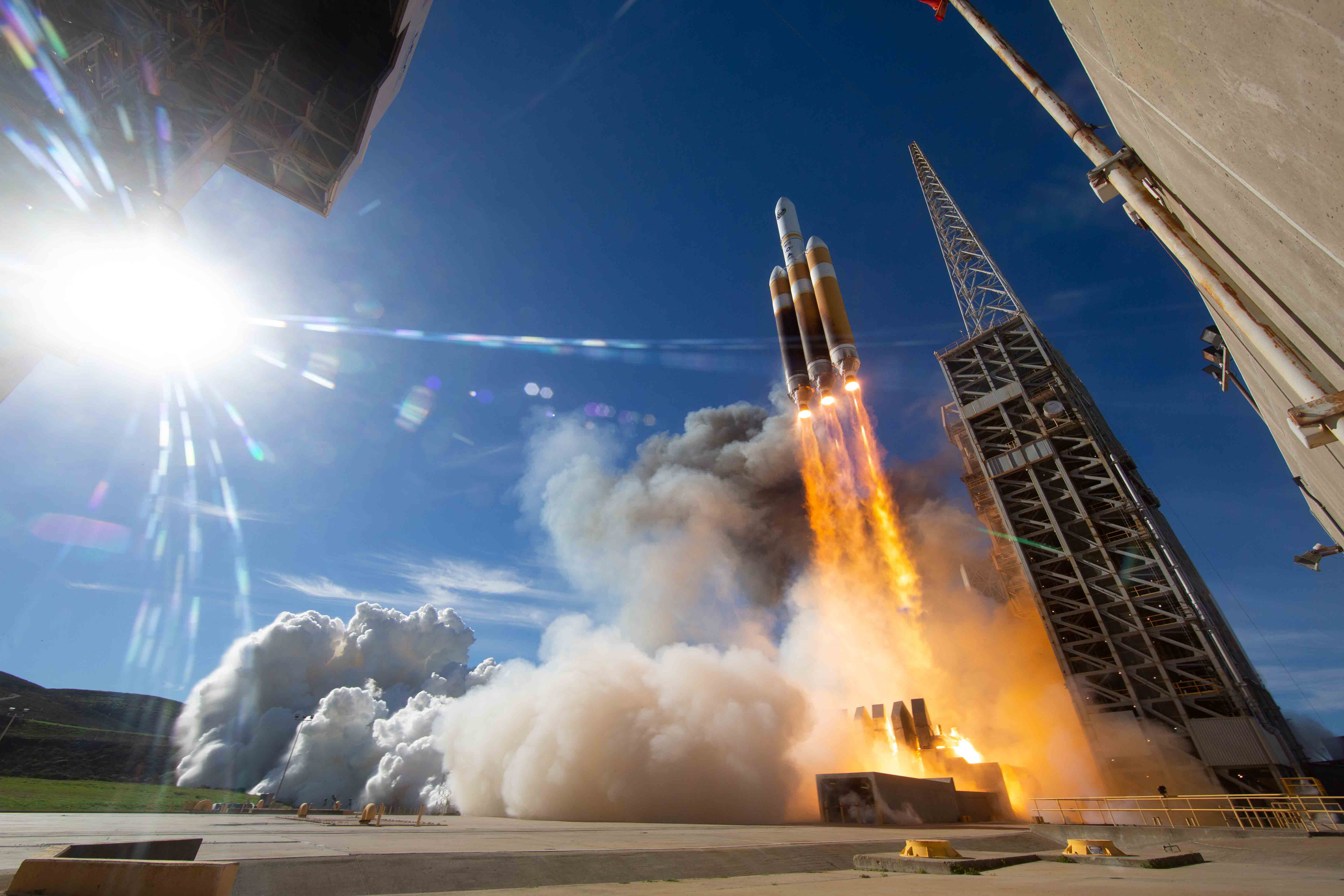
Photo by United Launch Alliance
United Launch Alliance Successfully Launches NROL-71 in Support of
National Security
Vandenberg Air Force Base, Calif., (Jan. 19, 2019) –
A United Launch Alliance (ULA) Delta IV Heavy rocket carrying a
critical payload for the National Reconnaissance Office (NRO) denoted
NROL-71 lifted off from Space Launch Complex-6 on Jan. 19 at 11:10 a.m.
PST. The mission is in support of our country’s national defense.
“Congratulations to our team and mission partners for
successfully delivering this critical asset to support national security
missions,” said Gary Wentz, ULA vice president of Government and
Commercial Programs, “thank you to the entire team for their
perseverance, ongoing dedication and focus on 100% mission success.”
The Delta IV Heavy is the nation’s proven heavy lift launch
vehicle, delivering high-priority missions for the National
Reconnaissance Office, U.S. Air Force and NASA. With its advanced upper
stage, the Delta IV Heavy can take more than 14,000 pounds directly to
geosynchronous orbit, as well as a wide variety of complex
interplanetary trajectories.
The mission launched aboard a Delta IV Heavy, comprised of three
common booster cores each powered by an Aerojet Rocketdyne RS-68A
liquid hydrogen/liquid oxygen engine producing a combined total of more
than 2.1 million pounds of thrust. The second stage was powered by an AR
RL10B-2 liquid hydrogen/liquid oxygen engine.
NROL-71 is ULA’s first launch in 2019 and 132nd successful launch since the company was formed in December 2006.
ULA's next launch is the WGS-10 mission for the U.S. Air Force
on a Delta IV rocket. The launch is scheduled for March 13, 2019 from
Space Launch Complex-37 at Cape Canaveral Air Force Station, Florida.
With more than a century of combined heritage, ULA is the world’s
most experienced and reliable launch service provider. ULA has
successfully delivered more than 130 satellites to orbit that provide
Earth observation capabilities, enable global communications, unlock the
mysteries of our solar system, and support life-saving technology.














